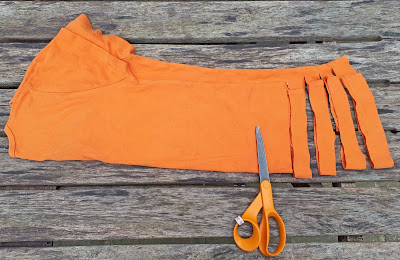 |
| My First Catalan Tray |
Recently I came across a YouTube video by Hanna Van Aelst showing how to weave a Catalan Tray. You can watch it here. As we had just been pruning the apple tree and had a variety of sticks as a result, I thought I'd have a go.
 |
| Prunings from the Apple Tree |
First, using a long stick, make a circle or an oval by bending the stick and wrapping the thin end round the thicker part. Be careful not to snap it. Then add a second branch. Start with the thick end where the thin end finished and carry on wrapping...
 |
| Making the circle/oval framework |
Tuck the ends in if you can and then trim the ends off...
 |
| Neatened up by trimming the ends off |
Choose 4 sticks that are longer than the circle. Lay them in pairs on your circle dividing it into 3. Try laying them in pairs with the thick end of one next to the thin end of the other...
 |
| Add the sticks that you are going to weave over |
Begin weaving across your tray going under and over as you go. Start in the middle and use your thicker sticks here. Alternate the under and over as you go and start each row from opposite sides so that you begin by coming from under your circle/oval. Poke the stick down from the front rather than bringing it up from behind. To go under the pair of sticks, go round the top, rather than poking it down and then bringing it back up. You are less likely to snap your stick this way. Keep squeezing your weaving together so that it is quite dense.
 |
| Begin weaving from the middle |
Keep going until you have filled in the circle...
 |
| Carry on weaving till you have filled the circle |
As you get nearer each end of the circle, bend your long sticks in to meet each other outside the circle. When you have filled in the circle, trim all the ends so they extend just beyond the circle. Bind the ends of the two pairs of long sticks together. I tried to do this with ivy but it kept breaking so I used some linen yarn...
Once you've done both ends, your tray is complete. I enjoyed this so much I made a second one...
 |
| Catalan Tray #2 |
Here they are together...
 |
| Finished Catalan Trays |
and then I tried making a small one. I added a fuchsia flower to give you an idea of scale and some hope...
 |
| Small Catalan tray |
I think this could be addictive. It does use more sticks than you imagine so make sure you have a plentiful supply. Thanks Hanna for your tuition!
Hanna has lots of other videos on YouTube if this has whetted your appetite. She also runs online workshops and has some beautiful baskets in her shop. Why not take a look?





































